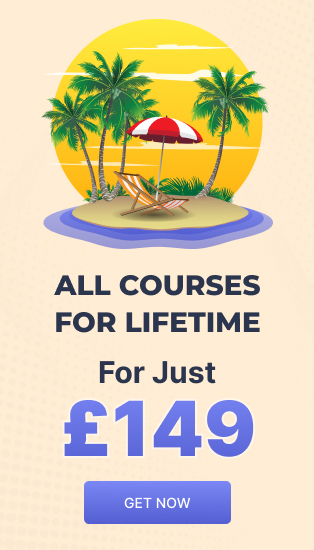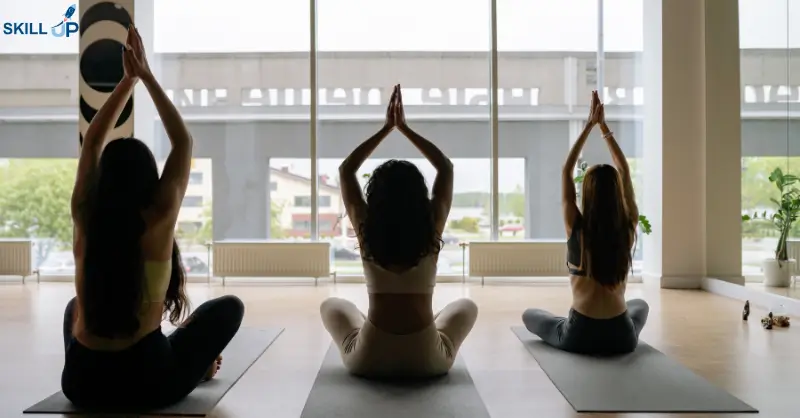
Yoga makes a difference. It activates your inner awareness by connecting your mind, body, and the environment. For many, yoga is a lifelong project to combat stress and promote relaxation. The simple poses and breathing exercises can help you feel good, gain more flexibility and strength, and keep unwanted thoughts away. This blog will explain why yoga works, the main components and categories, and the top 10 yoga poses for stress relief in 2024. In addition, you’ll learn about the equipment you need for your yoga practice.
Table of Contents
Why Does it Work?
Yoga is the road to awakening. It addresses all areas of the human system and is incredibly beneficial for physical and mental health. Moreover, it maintains bone strength, joint mobility, and stability. Yoga is mostly for stress relief. Through breathing exercises, meditation, mental imagery, and different stretching poses or asanas, yoga helps develop mindfulness and self-compassion. Again you can conveniently practice yoga in different places, such as at home, in classes, and outdoors.
Main Components of Yoga
Hatha yoga is a popular yoga style and dramatically helps relieve stress due to its slower pace and gentler movements. Below are the main components of hatha yoga:
Poses (Asanas)
Asana stands for body postures. It’s a physical position during a hatha yoga practice. The movements range from easy to complex, depending on a person’s balance, control, flexibility and endurance.
Breathing (Pranayama)
Pranayama is an ancient method of breath control. As you practice different yoga poses, you need to control your breathing to calm your body and mind. Inhaling and exhaling through your nose can help relax your mind and reduce stress stimuli. On top of that, it helps improve lung compliance.
Meditation (Dhyana)
Dhyana gives you a higher awareness of your consciousness. It helps you concentrate on vital things and develop an upbeat personality. You can train your brain to be in the moment, eliminate unwanted thoughts, improve your brain performance and get on top of the day.
Your Equipment Guide
The tools needed for yoga are simple and widely available. However, you need the right tools to get the most out of your yoga practice and have a rewarding experience.
Here are some equipment you may need on your daily practice:
Mats

The most common and essential piece of equipment for yoga exercises is a mat. It provides padding to reduce strains from different poses and insulates people from hot and cold surfaces. Various types of yoga mats are available, such as PVC mats and eco-friendly cork mats. However, investing in a good one will help you avoid injuries and have an enjoyable yoga experience.
PVC Mats
PVC mats are a popular choice as they are comparatively affordable and effective. They provide good grip and durability. However, PVC is non-biodegrable. You can only destroy them by burning. In addition, they can be slippery when wet and may emit odour.
Cork Mats
Cork mats, on the other hand, are free of toxins. In addition, they are renewable, and naturally antibacterial. The antibacterial properties make them less likely to smell. Moreover, they have a superior non-slip grip when wet. Therefore, they’re perfect for hot yoga and people who sweat excessively.
Pilates Rings
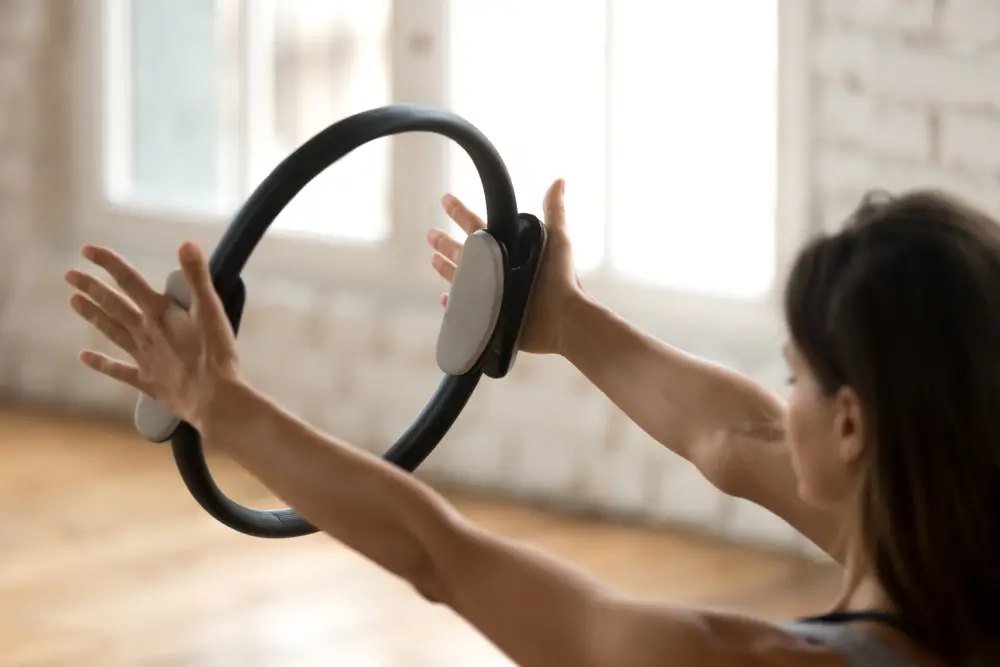
Next comes pilates rings, although they are used sparingly. These tools help stretch various muscles of the whole body, including the smaller and most neglected ones, for added resistance and flexibility. Moreover, pilates rings are durable and are made up of soft foam. They are made to support hands, feet and ankles when performing Pilates exercises. Hart pilates rings help tone and activate your upper and lower body muscles. They come in three different resistance levels. You can choose one depending on your strength and desired resistance level.
Yoga Wheels
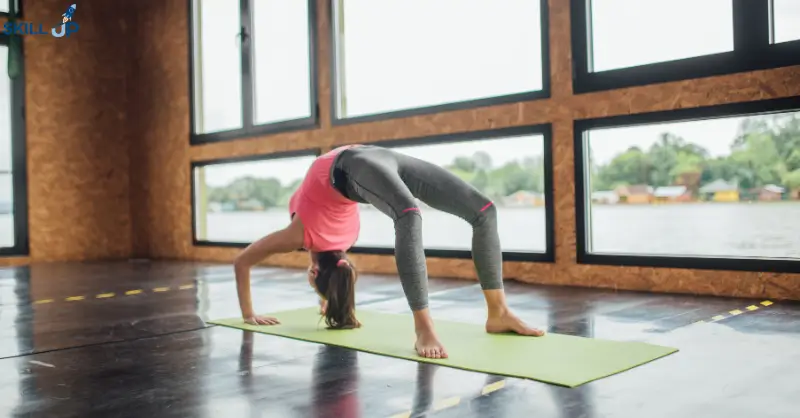
Another important yoga tool is a yoga wheel. It’s a hollow, circular prop made from plastic or wood. It is used for muscle relaxation and has several physical and mental benefits.
Yoga Blocks

Yoga blocks provide a grounding foundation for balance and stability during challenging poses. The main focus of using blocks is to extend the arms. However, they also support the back, hips, and head.
Yoga Socks

Yoga socks give you the required support in your ankle area. They provide warmth and are helpful for the poses that necessitate good grounding. Besides, the socks can help avoid slips and injuries.
Categories of Yoga Poses
Yoga poses are grouped into different categories to make the preparation easier. Let’s explore them:
Standing Poses
Each yoga practice begins with standing asanas. These basic grounding and centring asanas help build core stability, balance, mobility and flexibility. Again, the poses are often done for a gentle warm-up and to keep the body balanced before you start. You may do the standing poses in your hatha classes with rest between each pose.
Balancing Poses
Balancing poses help develop the core strength for many major types of yoga. By practising yogic balancing poses, you’ll identify the exact position of your body parts. Although it may seem difficult to initially engage your whole body in a balanced pose, regular practice can enhance your ability to balance.
Backends
Backends are great for spinal health and longevity. The poses help reduce tension, tightness, and pain. Initially, you’ll start with gentle spine flexion and extension, gradually moving towards advanced bends.
Seated Poses
It’s preferred to perform seated postures at the start and end of your yoga practice. These poses involve stretching the hips and hamstrings and are usually done after warm-up. While performing seated poses, you can sit on a folded yoga blanket or a softer mat for added comfort.
Supine Yoga Poses
Supine yoga poses, also known as resting poses, ensure your spine stays in a more natural position. During this practice, you must lie on your back while stretching your legs, hips, and abs. You can practice the poses during a yoga session whenever you need a break. However, supine poses may not always be comfortable. Therefore, make sure you use pros such as blankets to eliminate discomfort. The position indicates a restorative posture that uses gravity to influence passive stretching.
1. Child’s Pose (Balasana)
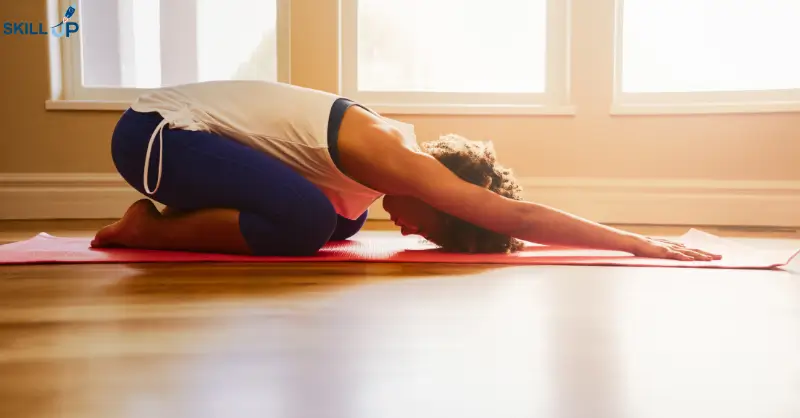
Pose type: Resting
The child’s pose involves relaxing your body and focusing on your inhale and exhale. It stretches your back, hips, thighs and ankles. Moreover, it’s a commonly used yoga pose to reduce back and neck pain. Practising the child’s pose is calming, as it helps relax your body after an intense pose or when you’re towards the end of your practice. Again, it improves your strength and balance.
Procedure
– Kneel down on the yoga mat and sit back on your heels.
– Slowly and carefully bend forward until your chest meets your thighs and your head touches the floor. Keep a soft cushion or yoga block underneath your tailbone for additional support.
– Take your arms back next to your thighs, palms facing up, or stretch them out in front of you, palms facing downward.
– Take deep inhales and exhales with your nose.
– Hold on to this position for a few minutes or as long as you like.
2. Bridge Pose (Setu Bandha Sarvangasana)

Pose Type: Backbend
The bridge pose allows the spine to experience gentle extension. It helps calm the mind and release tension in the body, reducing stress and anxiety.
Procedure
– Lie flat on your back and push your lower back into the ground to tighten your abdominal and buttock muscles.
– Create a straight line from your knees to the shoulder by raising your legs
– Squeeze your core and pull your belly button to the spine
– Wait for 20 to 30 seconds
– Lower your hips and return to the initial position
3. Downward Facing Dog (Adho Mukha Svanasana)

Pose Type: Standing/Balancing
This is one of the most common yoga postures. It helps stretch the whole body and improve blood circulation. Moreover, if you add it to your weekly practice, it can help alleviate chronic pain.
Procedure
– Come to your arms and legs on a yoga mat, keeping your knees underneath the hips and wrists underneath the shoulders.
– Push your fingertips down and take your arms forward while keeping your hands flat on the floor.
– Rotate your biceps forward to broaden your collarbones. Spread your fingers and roll your arms towards the front.
– Press your heels on the floor.
– Take a deep inhale and pull your toes towards you. Then, stretch your back and keep it as straight as possible. You can feel your calves, thighs, arms and shoulders stretch.
– Keep your neck relaxed and make your head hang without flexing muscles. Meanwhile, keep your shoulder blades away from the ears.
– Rotate your shoulder blades a couple of times.
– Breathe while tucking your feet inward, and breathe out while pushing your hips upwards.
– At this point, your body looks like a mountain. Hold this position for at least a minute.
4. Seated Forward Bend (Paschimottanasana)

Pose Type: Seated
Paschimottanasana is a classic yoga pose for hamstring, spine, and lower-back stretches. It stretches your whole back body, from the heels to the head. In addition, it provides a soothing effect on the body, which helps reduce anxiety. The practice balances the upper and lower body and tones the abdominal and pelvic organs.
Procedure
– Sit on the floor and extend your legs.
– Take a deep breath and sit tall.
– As you exhale, fold forward. Keep your back straight and slowly bend forward so your head moves towards your knees and shins. Rest your belly on your thighs to keep your spine long.
– Try to touch the bottoms of your feet or the tops of your shins with your hands.
– Hold this position for at least 10 seconds. Repeat as many times as you want.
5. Standing Forward Bend (Uttanasana)

Pose Type: Standing
This pose is similar to a seated forward bend, except that it requires standing. It’s an intense stretch pose that helps you stretch your hamstrings further. Moreover, it improves relaxation and calms the mind by balancing the nervous system.
Procedure
– Stand and keep your feet either touching or close together.
– Bend forward slowly as long as your hands touch the ground (go as far as you’re comfortable).
– Keep your fingertips in line with your toes. Exhale if possible.
– You can use a yoga block if your palms don’t touch the ground.
– Microbend your knees to ensure they are not locked.
– Stay in this position for at least 10 seconds or a few breaths, rising slowly afterwards.
6. Half Shoulder Stand (Sarvangasana)

Pose type: Backbend
This yoga pose involves raising your legs above your heart. It improves circulation and digestion, as well as better sleep and mood. In a few days of practice, you’ll notice the strength and flexibility in your back, shoulders, neck and legs. Again, the pose helps counter the effects of excessive sitting. However, you’ll need a wall or pillows for support during the practice.
Procedure
– Take a mat and lie down flat on your back. Keep your bottom close to the wall.
– Move your legs up the wall. Ensure your legs are parallel to the wall and your knees are straight but not locked.
– Remember that your spine should be straight and touching the ground. If you feel uncomfortable, move your hips away from the wall or bend your knees slightly.
– You can keep your arms next to your body.
– Inhale and exhale with your nose throughout the process.
– Hold the pose for at least a minute or as long as you’re comfortable.
7. Corpse Pose (Savasana)

Pose Type: Resting
This pose is reserved for the end of yoga practice. It’s a cool-down posture. Furthermore, practising corpse pose is beneficial for people with hypertension and insomnia.
Procedure
– Lie on your back. Separate your legs so they are as wide as your yoga mat.
– Relax your body completely, including your face. Again, face your feet and toes upwards and your hands by your side with palms up.
– Ensure that your head, neck and shoulders align with your spine.
– Take deep inhales and exhales through your nose. Maintain the position for five minutes or more.
8. Easy Pose (Sukhasana)

Pose Type: Seated
This pose involves sitting cross-legged. It promotes blood flow towards the lower abdomen for improved digestion. In addition, the pose helps improve body posture, flexibility, and stress reduction. This calming pose uplifts mood and is mainly used for meditation and breathing exercises. Yet, it is not suitable for those with spinal or knee injuries.
Procedure
– Sit on your yoga mat in a comfortable, cross-legged position
– Position your left foot under or right or vice versa, as per your comfort
– Keep your back straight and your head and neck in line
– You can rest your hand on your lap
– Sit with your palms facing down to feel grounded or up to be receptive
– Breathe in and breathe out repeatedly after 3 seconds.
– Hold this position for a minute, and then switch legs.
9. Happy Baby Pose (Ananda Balasana)

Pose type: Supine
The happy baby pose stretches the back, hips, and inner thighs. Like the corpse pose, it is also practised at the end of yoga classes. The pose is very relaxing after a workout. Besides, it calms the mind and helps alleviate stress and fatigue.
Procedure
– Lie flat on your back, keeping your feet extended to the ceiling.
– Bring your knees towards your torso. Meanwhile, keep your hip sockets soft so that your legs come up, but your hips stay down.
– Try to reach and hold your feet and pull lightly down.
– Make sure your entire spine socket remains attached to the floor.
– Gently rock from side to side so your hips and lower back can feel some stretch.
– Inhale and exhale slowly through your nose and maintain this position for a minute.
10. Cat-Cow (Chakravakasana)

Pose Type: Backbend
This pose stretches your spine as you slowly inhale and exhale. It’s a good stress reliever and calming practice as you connect your movements with your breathing. Again, the pose is simple and comes with different steps and benefits.
Procedure
– Get into a tabletop pose on all fours, aligning your hands under your shoulders and knees under your hips.
– Focus on the front of your mat to keep your neck long and neutral
– Arch your back upwards slowly by raising your abdomen towards the ceiling and bowing your head.
– Turn your head up as you push your belly towards the floor, causing a dip in your back.
– Inhale and exhale for a few minutes and switch between the two positions.
Conclusion
Yoga will open the door to peace and bring your trust in life. Along with promoting mental relaxation, it will make you stronger and more flexible. In this blog, we have discussed the benefits and major types of yoga. We have provided the equipment guide you need for your yoga practice. On top of that, we have outlined the top 10 different yoga poses for stress relief in 2024 that you can incorporate into your daily routine.
Frequently Asked Questions
Yoga reduces stress by promoting relaxation through a combination of physical postures, breathing exercises, and meditation techniques. The practice of yoga lowers levels of the stress hormone cortisol and enhances mood through the release of endorphins. Additionally, it increases mindfulness, which helps individuals manage stress more effectively.
The time it takes to experience stress relief benefits from yoga can vary depending on the individual and the consistency of their practice. Some people may notice immediate relaxation and mood improvement after a single session, while others might need a few weeks of regular practice to see significant changes. Generally, consistent yoga practice for about 4-6 weeks should provide noticeable stress reduction.
Beginners can practice yoga for stress relief. Many yoga classes and online resources are designed specifically for beginners, with modifications and instructions that make it accessible to everyone, regardless of experience level. Starting with gentle styles like Hatha or Restorative yoga can be particularly welcoming for newcomers.
Yoga can be effectively combined with other stress relief techniques to enhance its benefits. Practices such as mindfulness meditation, progressive muscle relaxation, deep breathing exercises, and regular physical exercise can complement yoga, creating a comprehensive stress management routine.







